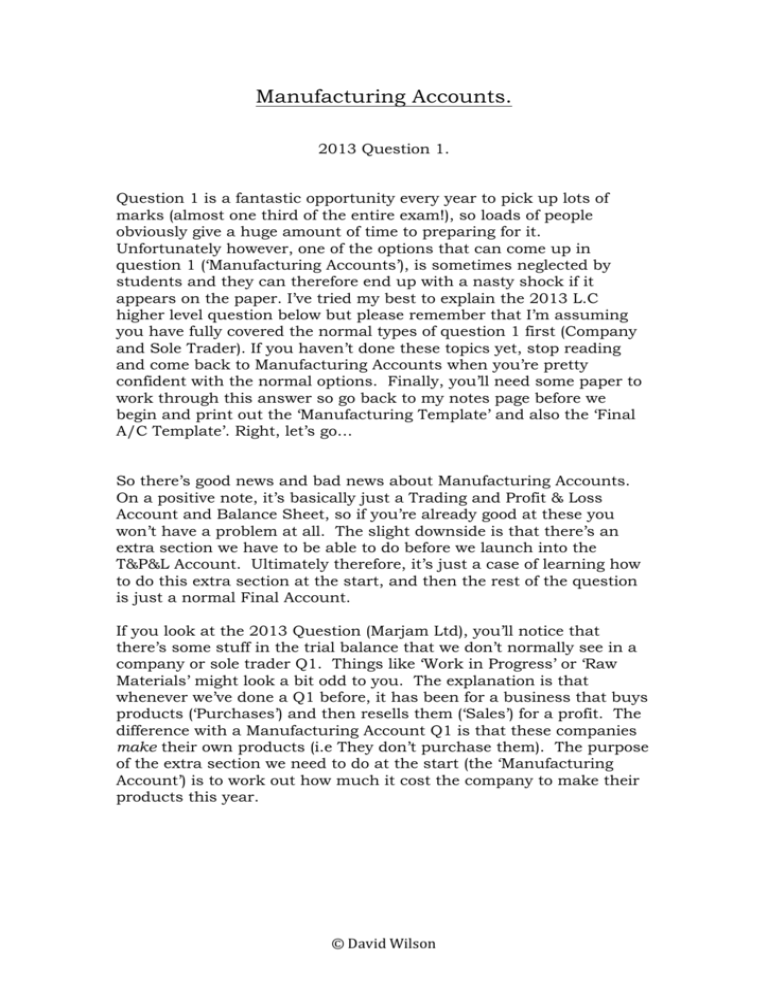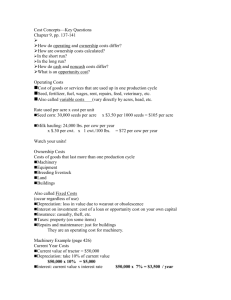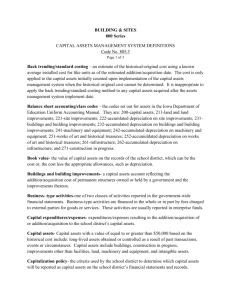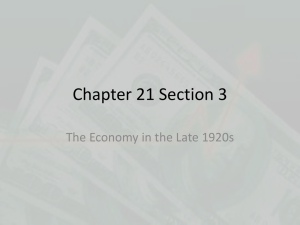Manufacturing Accounts.
advertisement

Manufacturing Accounts. 2013 Question 1. Question 1 is a fantastic opportunity every year to pick up lots of marks (almost one third of the entire exam!), so loads of people obviously give a huge amount of time to preparing for it. Unfortunately however, one of the options that can come up in question 1 (‘Manufacturing Accounts’), is sometimes neglected by students and they can therefore end up with a nasty shock if it appears on the paper. I’ve tried my best to explain the 2013 L.C higher level question below but please remember that I’m assuming you have fully covered the normal types of question 1 first (Company and Sole Trader). If you haven’t done these topics yet, stop reading and come back to Manufacturing Accounts when you’re pretty confident with the normal options. Finally, you’ll need some paper to work through this answer so go back to my notes page before we begin and print out the ‘Manufacturing Template’ and also the ‘Final A/C Template’. Right, let’s go… So there’s good news and bad news about Manufacturing Accounts. On a positive note, it’s basically just a Trading and Profit & Loss Account and Balance Sheet, so if you’re already good at these you won’t have a problem at all. The slight downside is that there’s an extra section we have to be able to do before we launch into the T&P&L Account. Ultimately therefore, it’s just a case of learning how to do this extra section at the start, and then the rest of the question is just a normal Final Account. If you look at the 2013 Question (Marjam Ltd), you’ll notice that there’s some stuff in the trial balance that we don’t normally see in a company or sole trader Q1. Things like ‘Work in Progress’ or ‘Raw Materials’ might look a bit odd to you. The explanation is that whenever we’ve done a Q1 before, it has been for a business that buys products (‘Purchases’) and then resells them (‘Sales’) for a profit. The difference with a Manufacturing Account Q1 is that these companies make their own products (i.e They don’t purchase them). The purpose of the extra section we need to do at the start (the ‘Manufacturing Account’) is to work out how much it cost the company to make their products this year. © David Wilson The two rules to remember are: - If you spot something in the question that doesn’t normally go in a question 1, it almost certainly goes in the Manufacturing Account. - We’re trying to work out a total cost here so all of the things we’re looking for are basically expenses or things we’ve spent money on to make our products. Hopefully you have the blank template for doing Manufacturing Accounts beside you (if not, go to my notes page and print one). You’ll be able to see the layout that is used to work out the total cost of manufacture. Don’t panic about the order things are written in the account, once you get everything in there somewhere, you should end up with the correct total. Let’s take it section by section on my template and see if we can make sense of it below… First up, we seem to have a heading for ‘Raw Materials’. I think it’s pretty obvious that this is a cost associated with manufacturing our products so it should be easy to remember to start with this. To get a figure for what we spent on raw materials this year we essentially get purchases of raw materials, add opening stock and minus closing stock. You’ll see in the template that there’s also a space for ‘Carriage on Raw Materials’ because if the trial balance gives us a figure for this, it’s an extra cost for us from getting our raw materials. In the 2013 question we have… € € € Raw Materials. Opening Stock 34400 Purchases 991600 Carriage In 4600 Closing Stock -35700 994900 Let’s see where all this came from. The opening stock of raw materials and the carriage on raw materials are both straight from the trial balance. The closing stock is also really straightforward - look at © David Wilson adjustment (i). The only thing needing a small explanation is the purchases of raw materials (which looks like €1,035,000 in the trial balance but is €991,600 in our answer above). There are two reasons for the difference. Firstly, in adjustment (iii) €400 of a repair was parts taken from our raw materials. Like in other topics, when stock of anything is lost, stolen, damaged, taken by the owners, etc, we need to subtract this from ‘Purchases’. I know that sounds weird but basically the word purchases in accounting means things we buy that we get to re-sell (or in a manufacturing account, things we buy that we get to use to make our product). So if the owners use raw materials for some other purpose, we can’t count them as ‘Purchases of Raw Materials’ because we’re not getting to use them to make our products. The second reason for the change in purchase of raw materials is a figure of €43,000 that we are subtracting because of adjustment (iv). This is the classic ‘sale of a van’ adjustment that we always see in Q1 but because this is a manufacturing account, they’ve called it a sale of machinery. It’s the exact same though. At the end of the adjustment we’re told that the new machine we bought cost €51,000 and that we got an allowance (or trade-in) of €8,000 for our old machine. We’re then told that the cheque for the balance (€51,000 - €8,000 = €43,000) was incorrectly recorded as the purchase of raw materials (which it wasn’t), so we need to subtract it. If you’re still hanging in there, then you’re doing fine. That’s about a third of the manufacturing account covered. My advice would be not to move on until you’re completely happy working out how to do the raw materials bit. Maybe pick another Q1 Manufacturing Account, have a go at the raw materials section and then check the solution to make sure you have it right. Once you’re happy, let’s look at the middle third… Direct Factory Wages 178800 Depreciation Plant & Machinery 29325 Depreciation Land & Buildings General Factory Overheads 31400 © David Wilson 239525 Ok, so what’s going on here? Right so remember that all of this stuff is in the manufacturing account because it’s connected to making our products. That’s why you’ll notice things have titles like Direct factory wages (ie They make it clear it’s to do with making the product by mentioning the word ‘factory’). If you see an expense in the trial balance and you’re not sure that it’s to do with manufacturing, then just put it in the normal expenses section of the P&L Account. In the section above, we start with factory wages and you’ll notice that the €178,800 figure is different from the €180,400 figure in the trial balance. The reason is in adjustment (iii). Basically we repaired some machinery and it cost €2000 (so that should be counted as repairs and we’ll put that at the bottom of the manufacturing account near the end). The problem is that they didn’t record it they way they should have and instead they recorded €400 of it as purchase of raw materials (remember we fixed this a few minutes ago?) and they recorded the other €1,600 as wages. Basically we simply take this €1,600 away from factory wages. Why? Because factory wages should be the figure for how much we pay our staff to make our products, NOT what we’ve paid them to fix faulty machinery. Ultimately this adjustment is asking us to record the repair where it should be (€2,000 repairs in the manufacturing account) and to undo the wrong thing they did originally (which was recording €400 of it as purchase of raw materials and €1,600 as wages). So next comes depreciation of plant and machinery. This goes in the manufacturing account because we obviously use machinery to make our products. If we are asked to depreciate vehicles or furniture or anything like that, these figures would go in the normal expenses section of the P&L account (because they have nothing to do with making the product). To work out depreciation on plant and machinery, we need to look at adjustment (iv). You might remember that this is exactly like the normal van adjustment that we see in almost every other Q1, so we need to break it down into two parts: For three months we had plant and machinery that cost €270,000. The cost figure is in the trial balance and the three months comes from the adjustment (they tell us that on the 31/3 they sold some of these). So there’s 3 months where we had €270,000 and the rate of depreciation is 10%. 10% of €270,000 for 3 months = €6,750 What happened on the 31/3 then was that we sold machinery that had cost us €20,000 and bought machinery that cost €51,000. So our machinery went down by the €20,000 one we sold and up by the €51,000 one we bought, which brings the total to €301,000. For 9 © David Wilson months of the year therefore (from 31/3 till the end of the year), we had machines that cost €301,00 and the depreciation is 10% of €301,000 for 9 months = €22,575 If you add the two depreciations together, you get the figure for the full year. €6,750 + €22,575 = €29,325. Easy! After this, you’ll probably have spotted that I have a line for ‘Depreciation Land and Buildings’, but no figure written opposite it. That’s because in this question we weren’t asked to work it out. Be careful though because the question would need to say ‘Depreciation on Factory buildings’ to be included in the manufacturing account (because the factory is where we make our products). If the question asks for depreciation on something that isn’t connected to making the product, then pop it in the regular P&L account (sorry I know I keep repeating this but it’s pretty important). Finally in the middle third of the manufacturing account, we have general factory overheads (which obviously go in the manufacturing account because they say ‘factory’) and the figure of €31,400 comes straight from the trial balance. At this stage, just like I said after the first third, it would probably be a good idea to stop and make sure you’re happy before going any further. Maybe get another question, attempt the middle third and then check your figures with the solution. If you’re happy, here’s the final section… © David Wilson Work In Progress Plus 1/1 23700 Minus 31/12 -27400 -3700 Sale of Scrap -3000 Hire of Special Equipment 6100 Patent Write Off Profit/Loss on Sale of Machine 500 Repairs to Machine 2000 So to explain what’s happening above… The first thing to understand is that ‘work in progress’ is simply the term used to describe products that we haven’t quite finished making yet. In other words, on the specific day when we do our accounts, it’s not going to work out nice and neat that we have a big pile of raw materials and a big pile of finished products. There’ll obviously be some stock which is kind of half way through the manufacturing process. This is called ‘work in progress’ and you’ll easily find the opening stock figure in the trial balance and the closing stock figure in adjustment (i). The next figure you’ll see in the answer is ‘sale of scrap’. This is almost the only minus figure in the whole manufacturing account because you’ll know by now that the manufacturing account is a list of costs. ‘Sale of scrap’ is money we have received from selling off bits of unused or unfinished products. It’s essentially a gain, you’ll see it in the trial balance, and you pop it in the manufacturing account as a minus (because it’s reducing our total cost of manufacture). Next comes ‘hire of special equipment’ which again is straight from the trial balance. It’s an expense so you might be tempted to pop it in the expenses of the P&L account, but as always, because we don’t see it in a normal Q1 and because it sounds like it might have something to do with making our products, it goes in the manufacturing account. After this you’ll see a line for ‘patent write off’ but we weren’t asked to calculate it in this question so there’s no figure for it. Patents are a unique and legal right to make a product a certain way so since they © David Wilson are connected to manufacturing, any write-off goes here (instead of in the expenses of the P&L account). Almost there! The second last figure is the profit/loss on the sale of the machine. I’ve already mentioned that adjustment (iv) is pretty much the normal van adjustment that we see in almost every Q1. In manufacturing accounts though, they change the item sold to a machine and as a result of this, all the stuff we work out goes in the manufacturing account. To calculate the profit or loss on the sale, you simply follow the normal routine… The machine had originally cost us: The total depreciation on it was: So we think it was worth: The buyer gave us an allowance of: So we lost: €20,000 €11,500 (69 months x 10%) €8,500 €8,000 €500 Finally, there’s a spare line on the template and this is so that you can add in anything random that pops up in the question (as long as it is clearly connected to making our products). In this case, there was the repairs to machinery of €2,000. I explained that a few minutes ago so hopefully we’re all ok with that. Right, so when you put the three sections together, you get the full manufacturing account… © David Wilson € € € Raw Materials. Opening Stock 34400 Purchases 991600 Carriage In 4600 Closing Stock -35700 Direct Factory Wages 178800 Depreciation Plant & Machinery 994900 29325 Depreciation Land & Buildings General Factory Overheads 31400 239525 Work In Progress Plus 1/1 23700 Minus 31/12 -27400 -3700 Sale of Scrap -3000 Hire of Special Equipment 6100 Patent Write Off Profit/Loss on Sale of Machine 500 Repairs to Machine 2000 Cost of Manufacture 1236325 © David Wilson The last thing to clarify then, is what happens next. Well don’t forget that the companies we do these accounts for make their own products, they don’t purchase them. So when you now go ahead and start the Trading & Profit & Loss Account, there won’t be a figure for ‘Purchases’. Instead of ‘Purchases’ in the trading account, we write ‘Cost of Manufacture’ and enter the answer from the manufacturing account above (€1,236,325). Other than that little change in the Trading Account, the whole rest of the answer is simply a normal Q1 (in fact a much easier Q1 because there are very few adjustments and they’re all pretty easy). The big challenge with this topic therefore is to practice and get comfortable with filling out the manufacturing account. Once you get the hang of that (and assuming you’re pretty confident with normal Q1s), the rest of the question is a doddle. As always, it’s all about practice. Get a full question and solution out and work your way through the answer, seeing if you’re happy where everything comes from. Then start having a go yourself with new questions (but checking figures from the solutions as you work) and then finally start trying full questions from start to finish (only checking the solution at the very end). If you’ve any questions, just ask. © David Wilson








